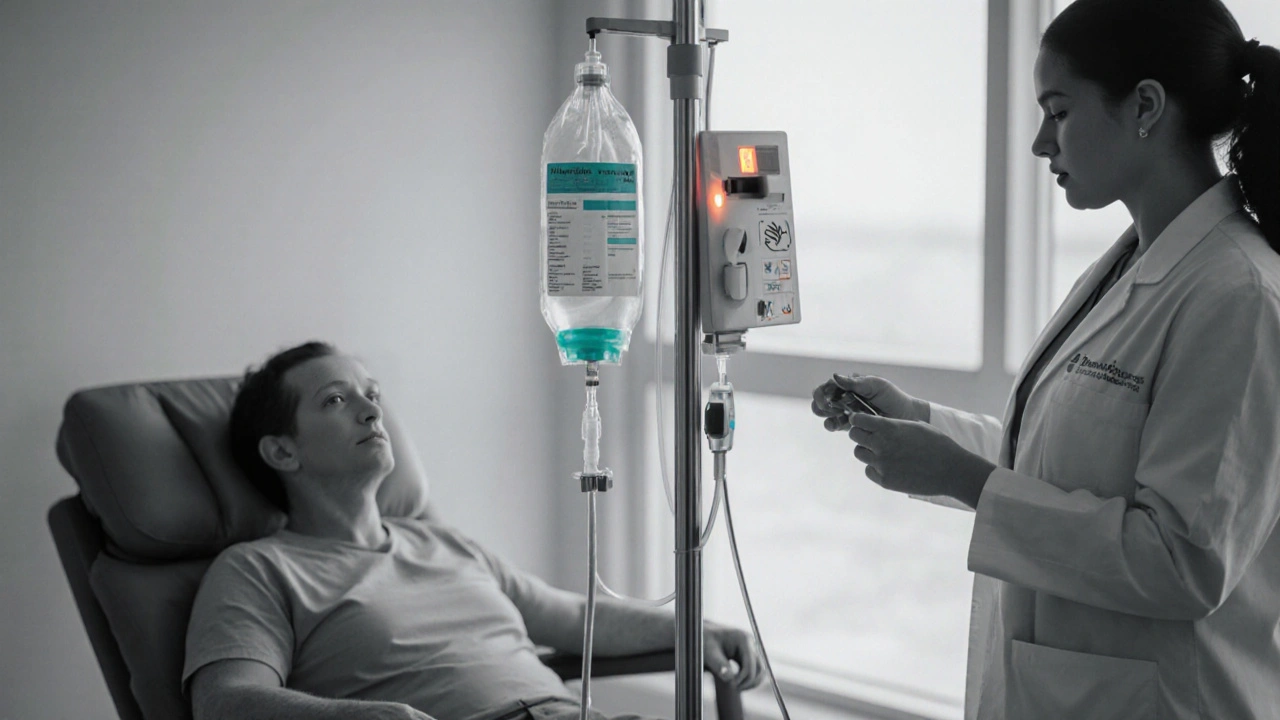Fluorouracil (5-FU) Dose Calculator
This tool calculates your fluorouracil (5-FU) dose based on standard medical dosing formulas. Doses are typically prescribed in mg/m² (milligrams per square meter of body surface area).
Note: This calculator is for educational purposes only. Always consult your oncology team for your specific treatment plan.
When doctors treat bowel cancer, they often turn to a drug called fluorouracil. This article breaks down what fluorouracil is, how it works against colon and rectal tumors, the most common regimens, how to handle side effects, and what you need to watch for during therapy.
Key Takeaways
- Fluorouracil (5‑FU) is a backbone drug for most curative and palliative bowel‑cancer protocols.
- It works by stopping cancer cells from making DNA, which forces them to die.
- Typical combinations include 5‑FU+Leucovorin (FOLFOX), 5‑FU+Oxaliplatin, or oral Capecitabine as a substitute.
- Common side effects are mouth sores, low blood counts, and hand‑foot skin reactions; early monitoring can keep them manageable.
- Genetic markers like MSI‑high status or KRAS mutation guide whether fluorouracil should be used alone or paired with targeted agents.
What Is Fluorouracil?
Fluorouracil is a pyrimidine analog that mimics the natural building block uracil. By inserting itself into DNA and RNA, it blocks the enzyme thymidylate synthase, halting the production of thymidine-a nucleotide essential for DNA replication. The drug is usually abbreviated as 5‑FU because its chemical name is 5‑fluoro‑2′‑deoxyuridine.
Developed in the 1950s, fluorouracil has become a staple in oncology because it targets rapidly dividing cells while sparing most normal tissues. Its effectiveness in colorectal, breast, and gastric cancers has been validated in dozens of clinical trials.
How Fluorouracil Works Against Bowel Cancer
Colon and rectal cancers rely heavily on DNA synthesis to grow and spread. Fluorouracil’s main action-blocking thymidylate synthase-creates a bottleneck in the folate pathway, leading to DNA damage and cell death. The drug also incorporates into RNA, disrupting protein synthesis. Because tumor cells divide faster than most healthy cells, they accumulate more of the drug’s toxic effects.
When combined with other agents that either enhance its uptake or target different pathways, fluorouracil’s killing power increases dramatically. That’s why you’ll often see it paired with Leucovorin, Oxaliplatin, or Irinotecan in modern regimens.
When Is Fluorouracil Prescribed?
Fluorouracil is used in several clinical scenarios for bowel cancer:
- Adjuvant setting: After surgery to remove a stageII orIII tumor, 5‑FU‑based chemotherapy reduces the risk of recurrence.
- Neoadjuvant setting: Before surgery for rectal cancer, fluorouracil‑based chemoradiation shrinks the tumor and improves resectability.
- Metastatic disease: For stageIV disease, 5‑FU is the core of most combination regimens, often with targeted drugs like bevacizumab.
- Palliative care: Low‑dose 5‑FU can help control symptoms when cure is no longer possible.
In many protocols, fluorouracil replaces the oral drug Capecitabine, especially when patients cannot tolerate the pill or when a continuous infusion is preferred.

Common Fluorouracil Regimens
Below are the most frequently used 5‑FU‑based schedules for bowel cancer. Dose adjustments depend on age, kidney function, and blood counts.
- 5‑FU+Leucovorin (LV): Also called the “Mayo” regimen, a bolus of 5‑FU (400mg/m²) is given on days1-5, with Leucovorin (20mg/m²) to boost the drug’s effect.
- FOLFOX: A modern combination of 5‑FU, Leucovorin, and Oxaliplatin (85mg/m² on day1) repeated every two weeks. It’s the standard adjuvant therapy for stageIII colon cancer.
- CAPOX (or XELOX): Replaces the infusion of 5‑FU with oral Capecitabine (1000mg/m² twice daily for two weeks) plus Oxaliplatin on day1, repeated every three weeks.
- FOLFIRI: Combines 5‑FU, Leucovorin, and Irinotecan (180mg/m²) for patients whose tumors are resistant to Oxaliplatin.
Each regimen has its own toxicity profile, and doctors choose based on tumor genetics, patient health, and previous treatment history.
Dosing and Administration Details
Fluorouracil can be delivered as a rapid bolus, a continuous 24‑hour infusion, or a combination of both. The continuous infusion is often preferred for metastatic disease because it lowers the risk of severe neutropenia.
Typical dosing examples:
- Bolus only: 400mg/m² IV push on day1, repeated every 4 weeks.
- Infusion only: 2400mg/m² over 46hours, repeated every 2 weeks (common in FOLFOX).
- Mixed schedule: 400mg/m² bolus followed by 2400mg/m² infusion over 46hours, repeated every 2 weeks.
Patients with liver impairment may need a 25% dose reduction, while those with renal dysfunction usually keep the same dose because fluorouracil is cleared mainly by the liver.
Managing Side Effects
Because fluorouracil targets fast‑growing cells, it also hits the lining of the mouth, the bone marrow, and the skin. Here’s what to expect and how to deal with it:
- Mouth sores (stomatitis): Rinse with warm saline several times a day, avoid acidic foods, and use a bland mouthwash.
- Low blood counts: Weekly CBC checks are essential. If neutrophils drop below 1.0×10⁹/L, the doctor may pause treatment.
- Hand‑foot skin reaction: Keep hands and feet moisturized, avoid hot water, and wear loose shoes. Dose reductions are common if grade2+reaction persists.
- Diarrhea: Start loperamide at the first sign of loose stools; stay hydrated.
- Nausea: Anti‑emetics like ondansetron are usually given before the infusion.
Early reporting of symptoms can prevent severe complications. Many oncology centers provide a 24‑hour nurse line for side‑effect queries.
Monitoring and Laboratory Tests
During fluorouracil therapy, the medical team tracks several labs:
- Complete blood count (CBC) - every week for the first two cycles, then every two weeks.
- Liver function tests (ALT, AST, bilirubin) - to catch early hepatotoxicity.
- Renal panel (creatinine, BUN) - especially in older patients.
- Electrolytes - low potassium can worsen hand‑foot syndrome.
If any values fall outside safe ranges, dose adjustments or treatment delays are made according to established protocols.

Comparing Fluorouracil With Other Bowel‑Cancer Drugs
| Drug | Administration | Typical Use | Main Toxicities |
|---|---|---|---|
| Fluorouracil (5‑FU) | IV bolus ± 24‑48h infusion | Adjuvant FOLFOX, metastatic FOLFIRI | Myelosuppression, mucositis, hand‑foot |
| Capecitabine | Oral tablets (1000mg/m² BID) | CAPOX, monotherapy for patients avoiding IV | Hand‑foot, diarrhea, liver enzyme rise |
| Irinotecan | IV infusion (180mg/m² every 2wks) | FOLFIRI, second‑line after oxaliplatin resistance | Severe diarrhea, neutropenia, cholinergic symptoms |
The choice among these agents depends on patient preference (IV vs. oral), prior exposure, and specific side‑effect tolerances. For many, fluorouracil remains the cheapest and most evidence‑backed option.
Special Considerations for Genetics and Age
Modern oncology looks beyond tumor size to molecular markers. Two key factors affect fluorouracil planning:
- MSI‑high (microsatellite instability) status: Tumors with high MSI often respond well to immunotherapy, so fluorouracil may be de‑escalated or omitted in favor of checkpoint inhibitors.
- KRAS mutation: While KRAS doesn’t directly change fluorouracil efficacy, it guides the use of EGFR‑targeted drugs, which are added to 5‑FU‑based regimens in KRAS‑wild‑type cases.
Older adults (≥70years) may have reduced bone‑marrow reserve. Studies suggest starting at 75% of the standard dose and titrating up based on tolerance reduces early toxicity without hurting outcomes.
Frequently Asked Questions
How long does a fluorouracil infusion take?
A typical continuous infusion runs for 46hours (about two days). Some protocols use a 24‑hour infusion, but the 46‑hour schedule is most common in the FOLFOX regimen.
Can I take fluorouracil and alcohol together?
Alcohol can increase the risk of liver irritation and worsen nausea. Most oncologists advise limiting or avoiding alcohol during treatment, especially if liver enzymes rise.
What should I do if I develop a severe hand‑foot reaction?
Stop using harsh soaps, keep the skin moisturized, and wear soft, breathable shoes. Notify your oncologist immediately-dose reduction or a temporary break is often needed.
Is fluorouracil safe during pregnancy?
Fluorouracil is classified as pregnancy category D. It can cause birth defects and is generally avoided unless the benefit to the mother clearly outweighs the risk.
How is response to fluorouracil monitored?
Doctors use imaging (CT or MRI) every 8‑12weeks, track tumor markers like CEA, and assess symptoms. A shrinking tumor on scans or falling CEA levels signals a good response.
Bottom Line
Fluorouracil remains a cornerstone of bowel‑cancer therapy because it reliably kills fast‑growing tumor cells while being affordable and well‑studied. Understanding how it works, the common regimens, and how to handle side effects empowers patients to stay on treatment and improve outcomes. With modern genetic testing and supportive‑care measures, you can tailor fluorouracil therapy to fit your health profile and maximize its benefit.
Remember, any decision about dosage, combination, or schedule should be made together with your oncology team. Open communication, regular lab checks, and prompt reporting of side effects are the keys to making fluorouracil work for you.

Fluorouracil is the alchemist’s fire of colon cancer therapy – it hijacks the tumor’s DNA factory. By masquerading as uracil, it throws a wrench in the replication gears, making cancer cells self‑destruct. The beauty lies in its simplicity: a tiny molecule, massive impact.
Understanding how 5‑FU works can really ease the anxiety of starting treatment. It interrupts the thymidylate synthase pathway, which many tumours rely on for rapid growth. Most patients tolerate the standard regimens well when side‑effects are caught early. Keep a symptom diary and stay in close contact with your oncology team.
In accordance with established oncological protocols, fluorouracil is administered either as a bolus or a continuous infusion. The selection of the administration schedule is predicated upon the therapeutic intent-adjuvant, neoadjuvant, or palliative. Dosage adjustments must be made in the presence of hepatic dysfunction or hematological toxicity. Routine monitoring of complete blood counts and liver function tests is indispensable. Failure to adhere to these guidelines may compromise both efficacy and safety.
5‑FU is cheap n works well but watch out for mouth sores and hand‑foot. keep hydrated and tell doc if blood counts dip
Fluorouracil remains the cornerstone of our national oncology arsenal, embodying decades of rigorous scientific endeavor.
Its mechanism, inhibiting thymidylate synthase, is a textbook example of targeted chemotherapy that any competent practitioner must master.
The drug’s widespread availability ensures that patients across all socioeconomic strata can access life‑saving therapy.
In our healthcare system, we prioritize evidence‑based protocols, and 5‑FU consistently demonstrates superior overall survival in stage‑III colon cancer.
Nonetheless, the administration demands meticulous scheduling; a continuous 46‑hour infusion is preferred for many regimens to mitigate neutropenia.
The dose must be reduced by twenty‑five percent in the presence of hepatic insufficiency, reflecting its hepatic clearance pathway.
Renal function, while less critical, should still be evaluated to avoid unforeseen complications.
Monitoring of complete blood counts on a weekly basis during the initial cycles is non‑negotiable, as rapid marrow suppression can precipitate severe infection.
Likewise, liver function tests must be repeated bi‑weekly to detect early signs of hepatotoxicity.
The dermatologic toxicity, known colloquially as hand‑foot syndrome, can be debilitating if not addressed promptly with emollients and dose modifications.
Patients should be counseled to avoid heat exposure and to wear breathable footwear.
Oral mucositis, another common adverse effect, can be ameliorated with saline rinses and bland diet modifications.
It is incumbent upon clinicians to educate patients about the importance of reporting any grade‑2 or higher toxicity without delay.
Failure to do so not only jeopardizes the current treatment cycle but also undermines future therapeutic options.
In the context of our national commitment to affordable cancer care, fluorouracil offers an unparalleled cost‑effectiveness ratio compared to newer, patent‑protected agents.
Consequently, while we embrace innovation, we must not abandon this proven workhorse that has saved countless lives.
Adhering to these guidelines reflects both scientific fidelity and patriotic responsibility to our fellow citizens.
Fluorouracil is a key drug for colon cancer. It helps kill quickly growing cells. The side effects can be hard, like sore mouth and skin problems. You should tell your doctor early if you feel bad. Regular blood tests keep things safe.
Sounds solid, just keep an eye on those labs and stay chill.
When I first read about fluorouracil, I was struck by the paradox of a tiny molecule wielding such formidable power over malignant cells.
It is as if the drug whispers to the DNA, urging it to falter, and in that hesitation the tumor meets its demise.
The regimens-whether FOLFOX, CAPOX, or FOLFIRI-each tell a story of collaboration between agents, a symphony of cytotoxicity orchestrated by oncologists.
Yet, the true heroism lies in the patient, who endures relentless infusions, navigates the throes of mucositis, and battles the fiery hand‑foot syndrome with stoic resolve.
Each infusion is a temporal bridge, connecting hope of remission with the stark reality of side effects.
The pharmacokinetics demand precise timing; a 46‑hour infusion will flood the system, smoothing peaks that a bolus would provoke.
Moreover, the genetic backdrop-MSI‑high tumors or KRAS mutations-casts a shadow that guides combinatorial choices, making personalized medicine no longer a dream but a practice.
In the corridors of oncology wards, nurses become the unsung custodians, monitoring CBCs, adjusting doses, and offering a soothing word when the nausea spikes.
The clinical trials that birthed 5‑FU are a testament to decades of relentless inquiry, each patient an involuntary contributor to scientific progress.
Financially, fluorouracil stands as a beacon of affordability, allowing health systems to allocate resources wisely while delivering curative intent.
I have seen survivors who, after months of relentless therapy, emerge with a renewed vigor that eclipses their pre‑diagnosis selves.
Their stories reinforce the idea that chemistry, when wielded responsibly, can rewrite destiny.
Let us not forget that the drug’s toxicity is a double‑edged sword; vigilance in lab surveillance is non‑negotiable.
Finally, the amalgamation of supportive care-mouthwashes, moisturizers, anti‑emetics-forms the scaffolding that lets patients traverse the arduous journey.
In sum, fluorouracil is more than a medication; it is a catalyst for survival, a testament to human ingenuity, and a rallying cry for perseverance.
Indeed, the saga of 5‑FU reads like an epic poem where the protagonist-our resilient patient-faces trials worthy of Odysseus.
From the bustling infusion chairs to the quiet moments of reflection, we witness a modern pilgrimage.
The cultural tapestry of oncology now includes stories of community support, where families gather around the infusion pump like storytellers around a hearth.
In many societies, the hand‑foot syndrome becomes a badge of honor, a visible reminder of the battle waged within.
Yet, we also see the artistry of nursing care, reminiscent of ancient healers applying balms to soothe wounded skin.
The interplay of science and humanity in these regimens mirrors the dance of jazz-improvised yet grounded in structure.
As we celebrate successes, let us also honor the quiet perseverance of those who endure side effects without fanfare.
The narrative continues across continents, each patient adding a verse to the collective chronicle.
Thus, fluorouracil is not merely a drug; it is a cultural artifact symbolizing hope, struggle, and eventual triumph.
Fluorouracil can be tough, but you’ve got this 😊
Hey there, just a heads‑up that staying on top of your labs can really save you from unexpected dose cuts. If you notice any weird fatigue or a sore mouth, chat with your nurse ASAP-they’ll tweak the schedule before things get worse. Also, keep a simple food diary; bland foods can ease the nausea that sometimes shows up. Remember, the goal is to keep the dose as strong as possible while staying safe. Good luck, and don’t forget to celebrate small wins along the way.
Think of fluorouracil as the sturdy oak in the forest of cancer treatments-deep‑rooted, reliable, and capable of withstanding fierce storms. Its ability to slip into the DNA of rogue cells and shut down their replication is nothing short of poetic. When paired with allies like oxaliplatin or leucovorin, it becomes a formidable brigade marching toward remission. Embrace the regimen, trust the supportive care team, and let the vibrant community of survivors cheer you on. Together, we’ll turn the tide against this disease, one infusion at a time.
What the modern layperson fails to grasp is that fluorouracil is not merely a pharmaceutical agent but a philosophical statement on the impermanence of cellular ambition. It embodies the Hegelian dialectic of thesis-cancer proliferation-and antithesis-chemical inhibition-culminating in a synthesis of apoptotic resolution. To contemplate its mechanism is to peer into the abyss of molecular determinism, where each nucleotide bears the weight of existential dread. Yet, in the clinical theatre, this abstruse construct is rendered tangible through infusion catheters and regimented cycles, a juxtaposition of lofty theory and gritty practice. One must therefore approach treatment with an intellect sharpened by both scientific rigor and metaphysical curiosity, lest the patient be reduced to a mere footnote in oncologic literature. In sum, fluorouracil demands reverence, not just as a drug, but as an emblem of humanity’s unyielding quest to dominate the microscopic adversary.